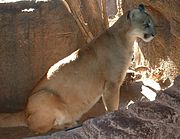First, let me repeat in case anyone has somehow managed to miss the bulletin: There is not a single case of a
healthy wild wolf fatally attacking a human being in North America. I'm not even sure we have any actual documented attacks, period. Unlike mountain lions, bears, heck even a really grumpy seal will take a bite out of you. So why does the wolf get such a bad rap? I'll tell you, its a mystery to me.
Now the mountain lion, you'll never see him coming. He attacks from ambush, pouncing from a ledge or hiding within sprinting distance on the downwind side of a trail. The mountain lion is solitary, and it seems to placate people to think that when they have a problem with a mountain lion they can just shoot that lion and the problem is gone. But wolves are pack animals. Even taking out the alphas might not solve a

problem, if the whole pack has learned an aberrant behaviour, such as killing livestock. And wolves stalk their prey. Maybe that's what people find so disturbing about them. The cunning, the study, the psychological game of cat and mouse that the wolf likes to play. Maybe there's something in the personality of wolves that reminds us of ourselves, and people find that offensive.
<-Ain't he go-jus? Whatever it is, its something that the people of North America brought over with them when they came from Europe and Asia. When North America was first settled wolves ranged the entirety of the continent, excluding only the deepest parts of the south. Before they were protected in the 1960's they were trapped and killed nearly to extirpation (or local extinction, as there were still plenty of wild wolves in Canada, Alaska, and parts of Europe) with as much as a 14 dollar bounty on their heads. Early trappers didn't much care what else they killed either, and some used poison laced carrion (usually strychnine) which could kill fifty wolves in one night, not to mention the ravens, coyotes and other scavengers it attracted. Sometimes the poison seeped into the ground and even poisoned the grass, long after the carcass was gone, and deer and elk would die. Long after that the bones of the dead animals might be chewed by another, and it too might die. By the time wolf recovery came around wolves were holding out in a very small population in northern Minnesota, but had been otherwise removed from the lower 48 states. Today helped in part by
Defenders of Wildlife's program which reimburses ranchers who lose stock to depredation wolf populations in the two main reintroduction sites in Yellowstone Natl. Park and Idaho are well up, and I'm proud to be a member of their "Adopt a wolf pup" program. I've also adopted a Bison, but though I am heartened that wolves have once again begun hunting their most fearsome natural prey in Yellowstone, I hope my wolf pup and my bison never meet!
So what is to stop the Grey Wolf from spreading further? Habitat encroachment for one. Game Hunting for another. In Alaska and Canada its still legal to hunt or trap wolves, but not so in the lower 48. So aside from wolves killed through the 'lethal control' plan which eliminates stock killers and other potential problem animals, wolves have to deal with human hunters sharing their food source. Only to the average human hunter it isn't a food source, is it? Its just a pretty rack of antlers to hang on the wall. I've actually had someone spot my 'adopt a wolf pup sticker' and read me the riot act about how wolves kill elk, which rightfully belong to human hunters. Right buddy. There ARE people who still hunt for food. And for them I'm sorry if Mr. Wolf got there first. But before we go shooting wolves for killing elk, why don't we say...limit hunting licenses for SPORT hunter's first? I mean, my god, what would you poor big game hunters do if you couldn't go out and kill something? Maybe play a video game. Try Deer Hunter. As for those of you out there who appreciate our wolves, I urge you to go to the Defenders of Wildlife's
'take action!' page and help stop them from exterminating wolves in the lower 48, and stop the barbaric aerial gunning in alaska! We still need 100,000 actions for halting aerial gunning to reach our goals!

This is a beautiful calender featuring wolves! Brought to us by
CreaturesGreatandSmall
Who could say no to a pupkiss? Lovely framed art tile, or search for other wolf designs at
DCR Images!


 problem, if the whole pack has learned an aberrant behaviour, such as killing livestock. And wolves stalk their prey. Maybe that's what people find so disturbing about them. The cunning, the study, the psychological game of cat and mouse that the wolf likes to play. Maybe there's something in the personality of wolves that reminds us of ourselves, and people find that offensive.
problem, if the whole pack has learned an aberrant behaviour, such as killing livestock. And wolves stalk their prey. Maybe that's what people find so disturbing about them. The cunning, the study, the psychological game of cat and mouse that the wolf likes to play. Maybe there's something in the personality of wolves that reminds us of ourselves, and people find that offensive.




